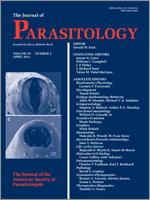Fecal samples from 126 insectivorous mammals in Madagascar were collected between spring 1999 and fall 2001. In the Afrosoricida, 21 species in 5 genera were sampled, including 17 species of Microgale (31/96, 32% infected), Hemicentetes semispinosus (1/2, 50%), Oryzorictes hova (1/5, 20%), Setifer setosus (8/13, 61.5%), and Tenrec ecaudatus (5/8, 62.5%); in the Soricomorpha, only Suncus murinus was examined and 1/2 (50%) were infected. Two morphotypes of eimeriid oocysts, representing 2 presumptive new species, were found in 47 (37%) infected animals; only 2 afrosoricid hosts (2% of all hosts, 4% of infected hosts) had both oocyst morphotypes. Sporulated oocysts of the first morphotype, Eimeria tenrececaudata n. sp., are subspheroidal, 18.8 × 17.4 (17–22 × 15–20), with a length∶width ratio (L/W) of 1.1 (1.0–1.2); they lack a micropyle but may contain 0–2 polar granules and a single, small round oocyst residuum, 3 × 2.3. Sporocysts are lemon-shaped, 9.9 × 6.6 (9–11 × 5–8), with a L/W of 1.5 (1.2–2.0); they have a prominent, slightly flattened Stieda body and a substieda body but lack a parastieda body. The sporocyst residuum consists of only a few granules between the sporozoites, which are sausage-shaped and have a large posterior refractile body. Oocysts of the second morphotype, Eimeria setifersetosa n. sp. are spheroidal to subspheroidal, 30.1 × 28.6 (27–34 × 25–34), with a L/W of 1.1 (1.0–1.2); they lack both micropyle and oocyst residuum, but 1–2 polar granules are usually present. Sporocysts are subspheroidal to broadly ellipsoidal, 9.6 × 7.3 (9–11 × 6–8), with a L/W of 1.3 (1.1–1.7); they have a broad Stieda body, lack sub- and parastieda bodies, and have a residuum of a few granules scattered throughout the sporocyst. Sporozoites were not clearly defined, but what seemed to be a single large refractile body is seen, presumably in each sporozoite.
How to translate text using browser tools
1 April 2011
Two New Eimerians (Apicomplexa) from Insectivorous Mammals in Madagascar
Lee Couch,
Juha Laakkonen,
Steven Goodman,
Donald W. Duszynski
ACCESS THE FULL ARTICLE

Journal of Parasitology
Vol. 97 • No. 2
April 2011
Vol. 97 • No. 2
April 2011




